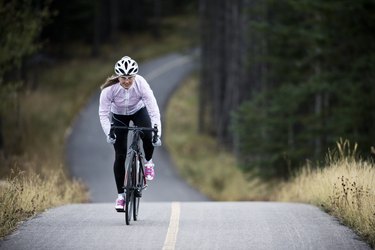
When it comes to packing on size, you need to do a lot more than cycling to get those monster quads and killer hamstrings you've been working towards. To experience muscle hypertrophy in your legs, you need to participate in a strength training program specifically designed for building muscle mass.
Tip
Bike riding is considered a cardiovascular exercise, which means the main goal is to increase your heart rate and burn calories. So unless you're hitting the weight room to train your legs consistently, don't expect huge gains in size just from cycling.
Video of the Day
Bike Riding and Your Legs
One question that comes up often is: "Will bike riding make my legs bigger?" For a select few, the answer to this question is "yes." According to an article in Bicycling Magazine, this is typically seen in highly competitive cyclists that follow a disciplined training plan that also includes power- and resistance-training workouts.
Video of the Day
But for the majority of people who are recreational cyclists or use bike riding for their cardio workouts, the answer will be "not so much." Sure, you may see a slight increase in the size of your legs if your training consists of high-gear bike rides that propel you up hills or push you through strong headwinds.
But the reality is, bike riding is best suited for increasing cardiovascular fitness, boosting your heart health and decreasing body fat. If you want to gain size in your legs, you will need to add a minimum of two to three days a week of resistance training that focuses on lower reps and higher weight.
Read more: Is an Exercise Bike Good for Cardio?
How to Increase Leg Size
While the general recommendations for health call for a minimum of two to three days of resistance training, to experience increases in muscle hypertrophy, the National Strength and Conditioning Association (NSCA) says you need to train with higher volumes and heavier loads.
Which means, if muscle definition and making your legs bigger is a primary fitness goal, then you need to understand exactly how to get it done when you go to the gym. According to the American Council on Exercise, aiming for a rep range of eight to 15, with the last rep achieving momentary fatigue, is a smart way to train for muscle size and definition. With that in mind, it's important to point out that the lower rep range of eight should equate to higher resistance and the higher rep range means lower resistance.
For example, if your goal is to increase the muscle size in your legs, you should include a compound exercise such as squats. When performing squats, aim for three sets of repetitions with the first set totaling 12 repetitions, the second set 10 reps, and the final set eight repetitions, the weight or resistance should be heavier when you get to the last set.
Read more: Which Muscles are Used When Riding a Bike?
Fat Loss and Hypertrophy
Cranking out the miles on a road bike, mountain bike or exercise bike does work the major muscles in your lower body, but that doesn't mean your legs are going to get bigger. In fact, since bike riding is considered a cardiovascular or aerobic activity — you might actually lose weight or decrease the size of your legs if you burn enough calories.
According to the Centers for Disease Control and Prevention, a 154-pound person can burn anywhere between 145 and 295 calories per 30-minutes of bike riding. If your training routine consists of frequent rides lasting longer than one hour, you could potentially burn over 600 calories each time you head out on your bike.
To improve muscle strength and increase the size of your legs, the NSCA recommends three to four days per week of strength training for intermediate levels and four to six days for advanced levels. At least two to three of those training sessions should focus on compound exercises that target the lower body. Some good examples include:
- Squats
- Deadlifts
- Lunges
- Single-leg deadlifts
- Box step-up with weights
- Kettlebell swings
- Kettlebell goblet squats
- American Council on Exercise: "How Quickly Does Muscle Grow?"
- American Council on Exercise:"How Many Reps Should You Be Doing?"
- Centers for Disease Control and Prevention: "Physical Activity for a Healthy Weight"
- American Heart Association: "Recommendations for Physical Activity in Adults and Kids"
- National Strength and Conditioning Association: "Determination of Resistance Training Frequency"
- Johns Hopkins Medicine: "3 Kinds of Exercise That Boost Heart Health
- Bicycling Magazine: "Will Cycling Make Your Legs Bigger?"